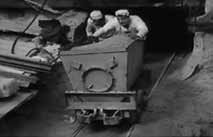23:43
Lina Selander’s film Lenin’s Lamp Glows in the Peasant’s Hut is a work with many points of entry. One of the film’s points of departure is the 1986 nuclear disaster in Chernobyl, Ukraine. While making the film, Lina Selander visited Pripyat, the town founded to house workers for the nuclear power plant, and, on site, photographed the contaminated zone. She also gathered material from the museum in Kiev that administers the historical heritage of the accident.
The film begins with a sequence of images from the approach over the snow-covered countryside surrounding Kiev. The ground below floats away in a horizontal movement while Selander establishes the vertical movement that corresponds to the distance between the viewer’s gaze and the ground far below. These two movements recur in several aspects of the film.
Pripyat is located on a tributary of the Dnieper, upstream from Kiev. On the shores of the Dnieper is also where the 1928 film Odinnadcatyj [The Eleventh Year] by the Soviet film director Dziga Vertov takes place. The film, which celebrated the tenth anniversary of the Soviet state, depicts the construction of a power plant, focusing on electricity as the prerequisite for the development and progress of modern society. The title of Selander’s installation is borrowed from an intertitle in Vertov’s film and the artist also uses footage from The Eleventh Year in order to connect the utopian dream from the first decade of the Soviet state with a contemporary set of problems in regard to modern society’s insatiable need for power and its consequences, as well as with the role of the mediums of film and photography in this development.
Vertov’s famous statement, “I am the machine /—/” echoes in Selander’s film. The human being as machine, a component of the social structure, is a consistent theme that addresses the reduction of the human being to labour, subordinated to ideological systems. Against Vertov’s Soviet workers who radiate youth, pioneering spirit and enthusiasm, the artist places images of the liquidators – decontamination workers – who, after the nuclear disaster, were despatched to dig a tunnel under the reactor and who all died shortly after, from injuries sustained. The montage is completed with pictures from the museum in Kiev and from Pripyat’s abandoned schools, houses and hospitals.
The historical parallel that Selander draws between the Soviet power plant construction and today’s dead zone in Pripyat is carried forward through an image of a Scythian grave borrowed from Vertov. The image, which in Vertov’s film functions as a reminder and a continuation of the proud heritage from a long-gone civilisation, establishes, in Selander’s work, a historical shaft that extends much further and deeper down into a pre-historic time. A series of pictures of plant fossils and drawings of how the original forests may have looked find their counterpart in nature images from Pripyat, a place where human history has come to an end and where nature has been left to heal itself.

